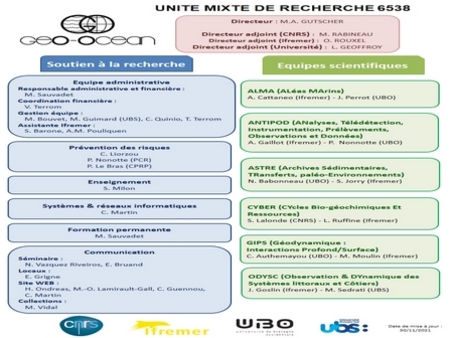III.- FREE-FALL GRAB - ED1
(Poster 4)
Also known as samplers and "boomerang" cameras, the ED1 device was developed in the studies conducted co-jointly by the CNEXO and Le Nickel Company to carry out exploration for polymetallic nodules in the Pacific Ocean. It allows simultaneous sampling and photography.
III.2.1. Free-fall grab ED1
Description of equipment. The ED1 device consists primarily of three parts:
- Buoyancy equipment with tracking system (flag, tags and radio devices).
- A sampler for the recovery and transport superficial samples.
- A camera placed above the sampler, allowing to shot obliquely to the vertical.
Principle :
The device, released from the surface descends independently thanks to its weight. The journey from surface to bottom varies from 2 to 4 hours for a depth of 4 to 5,000 m. It automatically performs sampling as from bottom contact (sampling an area of 0.18 m) at the water-sediment interface, takes a slightly oblique picture about 1 m 2 the sea bottom and, then, in releasing its weight, begins its return to the surface.
On its appearance at the surface, it is located by the presence of a flag and night flash as well as direction finding through the a radio beacon.
Application: Exploration of seabed above 3.000 meters.
Use: Used for the recovery of nodules and surface sediment, it was widely used at the beginning of nodule exploration in the Pacific Ocean.
Implementation: Easy implementation means from most sea modest, no special equipment required.
Advantage: Rapidely, low cost. Mechanical device with little electronics, easy to use. Few grabs lost, their location on the surface and their recovery take place quickly and succesfully. Can be released and recovered at night.
Disadvantages: Randam positioning of sampling on the merits. Depending on how the gear double bottom, the following problems may arise:
- removal of only part of the surface,
- unable to collect the biggest of nodules and losts of the smaller nodules. Accordingly, the results of the evaluations of the quantity of nodules will be less than the reality.
The photographs only observe the exterior surface of nodules.
III.2.2 .- The different morphological facies of nodules
An examination of photographs obtained by the ED1 device enabled to recognize different morphology facies.
A comparison between pictures and chemical analysis of the nodules showed that there is a relationship between morphology and chemical composition.This allowed to classify nodules into three main geochemical families (or facies) based on the following criteria:
- Distribution of nodules on the seabed,
- The estimated average diameter,
- Relations between the sediment and nodules,
- The presence or absence of sterile.
Facies A
It is composed mainly (70 to 100%) of small adjoined nodules (nodule compounds) of complex shapes and smooth surface. There are also debris of old (0 to 30%) nodules of this type.The nodules are not embedded in the sediment. They are accompanied by debris of volcanic rocks and frequently associated with rocky outcrops or crusts.The high silica content (12 to 23%) results in the presence of a nucleus and impurities of volcano-sedimentary origin.Ferromanganese hydroxides are poorly crystalline structures with confused or laminar structures.
Facies B
Most nodules are ovoid. There are still some polynodules and old debris. Their surface is smooth, sometimes mamillated. They are still associated with pumice and rock crust debris.The nodules are not embedded and are distributed on the bottom evenly.Hydroxides are again poorly crystallized with laminated structures and are not organized.
Facies C
Nodules are much bigger, with a clear equatorial board. They are buried in the sediment to their rim and often covered with a thin layer of sediment partly hiding them.
Their distribution on the seaflor is more heterogeneous.
Hydroxides are well crystallized and have the same characteristics as the B facies.
The boundary between facies B and C is not straightforward. The transition from one to another is done gradually.
III.2.3. Conclusion
FACIES | A | B | C |
|---|---|---|---|
Diameter (b)* (mm) | 20-30 | 30-70 | 50-100 |
Roundness (b/a)* | Shape | 0,74 | 0,69 |
Flatness (c/b)* | complex | 0,64 | 0,75 |
Population (%) | 28 | 31 | 13 |
Density (kg/m 2) | 5,2 | 11,8 | 7,8 |
Mn (%) | 19-26 | 28-31 | 25,4-31,2 |
Fe (%) | 6-10 | 5,5-6,5 | 4,6-6,8 |
Ni (%) | 0,5-0,9 | 1,15-1,3 | 1,05-1,25 |
Cu (%) | 0,25-0,35 | 0,26 | 0,23 |
Co (%) | 0,25-0,35 | 0,26 | 0,23 |
Si02 (%) | 12-23 | 12-17 | 12-14 |
* With a> b> c: the three axes of a nodule represented as an oblate spheroid.
Main features of different facies nodules.
Photographs taken by the ED1 device allowed the study of the morphology and density of nodules on the seabed, important data for calculating the concentration of nodules kg/m 2.
As for sampling, in addition to the information they provide on the morphology of nodules, they enable their chemical analysis onshore. These two parameters (morphology and geochemistry) allow the calculation of the amount (percentage) of useful elements such as Mn-Ni-Cu-Co.
Thus, knowing the geochemistry of the three geochemical facies, it is easy, through interpretation of photos to identify areas of economic interest. Consequently AFERNOD replaced punctual sampling by continuous submarine photographs of the bottom with other devices (see Poster 7).







